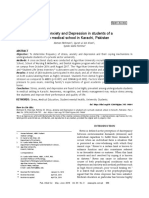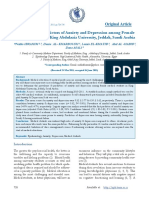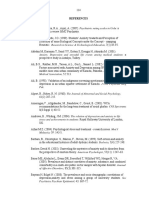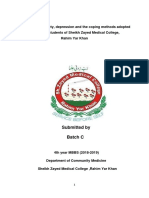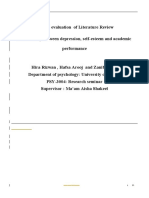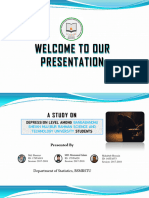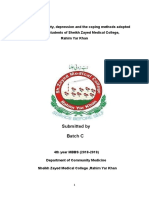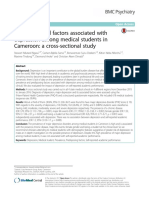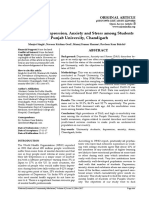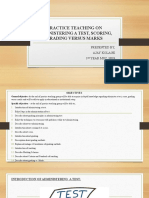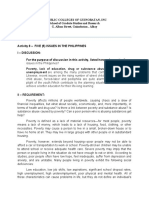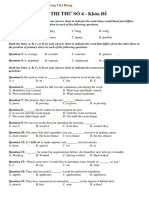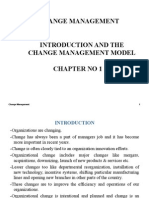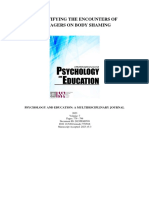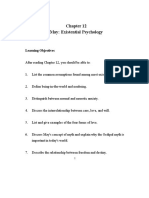Comparison of Depression, Anxiety and Performance Scales
between Medical Students Who Opted To Study Medicine on Their
Own and Those Who Chose It under Parental Pressure
Submitted By:
Ali Mehdi and Shan-e-Zainab
2nd Year MBBS, NMU Multan
Research Supervisor:
Dr. Hamid Hassan
Assistant Professor Department of Physiology
Nishtar Medical University, Multan
1
�2
�APPROVAL OF SYNOPSIS FROM ETHICAL COMMITTEE
It is Certified that we have read the synopsis titled “Comparison of anxiety,
depression and performance scales between medical students who opted to study
medicine on their own and those who chose it under parental pressure ”
submitted by Dr. Hamid Hassan, Shan-e-Zainab & Ali Mehdi. We have found it
acceptable ethically and hence it is approved.
Professor Dr. Mustafa Kamal Pasha
Vice Chancellor, NMU
&
Patron of Ethical Review Board
3
�TABLE OF CONTENTS:
List of Abbreviations……………………………………………………………… 5
Project Summary………………………………………………………………….. 6
Introduction……………………………………………………………………….. 7
Hypothesis………………………………………………………………………… 9
Study Objectives………………………………………………………………….. 10
Materials and Methods…………………………………………………………… 11
Ethical Issues………………………………………………………………………. 14
Methodology………………………………………………………………………. 15
Data Collection Procedure and Study Variables………………………………… 26
Statistical Analysis………………………………………………………………… 27
Outcomes and Utilization…………………………………………………………. 28
Expected Expenditure……………………………………………………………... 29
References……………………………………………………………………………30
Annexures……….…………………………………………………………………… 33
Plan of Work………………………………………………………………………. 35
4
� LIST OF ABBREVIATIONS
WHO World Health Organization
AKUADS Aga Khan University Anxiety And Depression Scale
BDI Beck’s Depression Inventory
BMI Body Mass Index
WC Waist Circumference
WHR Waist Hip Ratio
5
�PROJECT SUMMARY:
Students, in our society, face different dilemmas. One of them is parental pressure under which
they are forced to choose a field of study against their will and aptitude. Students who are
forcefully sent to medical institutes against their desires are more liable to suffer from depression
and anxiety as compared to those who had opted medicine on their own. Logically these
students, who had been forced to opt medicine, would score less on academic scales. In this
study we shall compare levels of depression and anxiety between two groups of medical
students, i.e. between those who opted medicine on their own and those who opted it under
parental pressure, and shall try to derive a correlation between their depression, anxiety and
performance scores.
6
�INTRODUCTION:
Depression is a common medical disorder that negatively affects the feelings, thinking ability,
daily life’s interactions and relations along with behavior of a medical student. [1] The term
depression describes a wide range of disturbed emotions and feelings which can range from
mere worrisome state to a whole turmoil of psychological status where an individual can
develop suicidal intentions.[2] It has been projected by researchers that depression negatively
affects the life of medical students and their daily activities like any other strata of society. [3]
Anxiety is a state of diffuse apprehension that is unclear in nature and is associated with feelings
of uncertainty and hopelessness.[4] High levels of stress have been documented in medical
students in various studies.[5] Contemporary studies have projected that though medical students
in the middle of their academic career depict higher scores of depression and anxiety but the
compulsive and irrational symptoms, that constitute the common presentation of these disorders,
are rather more prevalent in medical students who have just initiated their academic career. [6]
Anxiety and depression are psycho-psychiatric disorders that usually co-exist with each other 7].
Researchers have found that both depression and anxiety negatively affect several aspects of a
medical student’s life including his/her academic performance. [8] It has been projected that poor
academic performance, associated with depression and anxiety, has a negative effect on a
student’s self-esteem and causes negative emotions to emerge [9]. Persistence of these disorders in
the long run can prevent medical students from re-establishing their self image and restoring the
efficacy of their maximum potentials [9][10] .
In Pakistan the prevalence of anxiety and depression is much higher as compared to other
developing countries like that of Turkey(27.1%)[11] ,Sweden(12.9%)[12], Brazil(40.2%)[13] and
7
�Iran(44%)[14]. The prevalence of anxiety and depression amongst medical students, measured on
AKUADS scale, has been put at 45.5%.[15]. However, research studies who did use BDI to find
prevalence of depression and anxiety, instead of AKUADS, have projected a value of 51% [16].
In Pakistan medicine is one of the most esteemed professions, especially in the eyes of the
parents of current era and most of them do push their children to peruse it regardless of their
aptitude and desires. This is most likely to affect them on psycho-psychiatric grounds causing
them to develop both depression and anxiety more easily and frequently.
No research till now has been conducted in medical students of Pakistan to find the prevalence
of depression and anxiety in medical students who have been pushed into medical colleges by
their family. This research shall compare the prevalence of depression and anxiety, between
medical students who chose medicine on their own and those who opted it under parental
pressure, on AKUDAS and BDI, and shall try to correlate it with scores of their academic
performance too.
8
�HYPOTHESIS:
Students who were forced to choose medical studies by their parents have higher incidence of
depression and anxiety as compared to those who opted medicine on their own and depression
and anxiety scores are inversely correlated to the academic performance of medical students.
9
�STUDY OBJECTIVES:
1. To compare depression and anxiety scores between medical students who opted medicine
on their own and who didn’t.
2. To correlate depression and anxiety scores with academic score in medical students who
opted medicine on their own and in those who didn’t.
10
�MATERIALS AND METHODS:
Study design:
Cross sectional Comparative
Setting:
Study shall be conducted within the premises of the department of physiology Nishtar Medical
University & Hospital, Multan through the collaboration between the departments of physiology
and behavioral sciences
Duration Of Study:
Study shall be carried out within one month after the approval of the synopsis.
Sample Size:
The sample size for each group is calculated with a power of 90%, an alpha level of 5% by using
the differences in mean levels of depressive scores (of depressive and non-depressive
individuals) in the following formula. The formula has been taken from the software “Sample
Size and Determination in Health Studies – A Practical Manual version (2.0.21) by WHO
Geneva”.
is given as:
n = 2σ 2 ( Z 1-α/2 + Z 1-β) 2
(µ0 - µ1)2
11
�Where,
n = 23
σ = Population Standard Deviation (σ = 3.29)
σ 2 = Population Variance (σ 2 = 10.8241)
α = Level Of Significance (α = 5)
1-β = Power Of Test (1-β = 10)
µ 0 = Test Value Of Population Mean (µ 0 = 1.70)
µ 1 = Anticipated Population Mean (µ 1 =2.36)
The above mentioned values have been calculated from the differences of depression scores,
among various groups, projected by work of John Palner and Maurice B. Mittelmark. [17]
Sampling technique:
Convenience sampling
Study Population:
Group I: 23 students who were forced to opt medical profession by their own.
Group II: 23 students who were forced to join medical profession by their parents.
12
�Sample Selection:
Age, Gender and Ethnicity matched male medical students.
Inclusion Criteria:
1. Male students with ages between 18-23 Years.
2. Male students with a BMI ranging between 18 to 24.9
3. Male students having WHR ≤ 0.9 will be included.
Exclusion Criteria:
1. Those with a past history of endocrine imbalance.
2. Those with previous history of psychiatric illness.
3. Those who are or have been on recreational drugs.
4. Those with a family history of depression and anxiety.
5. Those with a BMI > 24.9 and WHR > 0.9.
13
�ETHICAL ISSUES:
This study shall be conducted as per Helsinki declaration of human right after approval of
research synopsis by the ethical review committee of Nishtar Medical University, Multan.
14
�METHODOLOGY:
Cases will be selected from Nishtar Medical University, Multan using inclusion and
exclusion criteria.
Written and informed consent will be taken.
History will be obtained and recorded on a Proforma.
Body Mass Index (BMI) of the subjects will be calculated by using the following formula
BMI = Weight (Kg)/Height (m2)
Waist Hip Ratio (WHR) of the subjects will be taken into account by taking waist
circumference at level of umbilicus and hip circumference at widest portion of hips.
To assess academic performance, student’s achieved % in last professional examination,
shall be recorded.
To measure anxiety and depression, Aga Khan University Anxiety and Depression
Scale[18] and Beck’s Depression/Anxiety Inventory will be used. These scales are given
below:
15
�Table I. The Aga Khan University Anxiety and Depression Scale (Translated From Urdu).
Don’t Know Never Sometimes Mostly Always
S.
No.
9 0 1 2 3
In the past 2 weeks:
1 Have you been sleeping less?
2 Have you had lack of interest in your daily activities?
3 Have you lost interest in your hobbies?
4 Have you been anxious?
5 Have you had a sensation of impending doom?
6 Have you had difficulty in thinking clearly?
7 Have you preferred to be alone?
8 Have you felt unhappy?
9 Have you felt hopeless?
10 Have you felt helpless?
11 Have you been worried?
12 Have you cried?
13 Have you thought of taking your life?
14 Have you had loss of appetite?
15 Have you had retrosternal burning?
16 Have you had indigestion?
17 Have you had nausea?
18 Have you had constipation?
19 Have you felt difficulty in breathing?
16
� 20 Have you felt tremulous?
21 Have you felt numbness of hands and feet?
22 Have you felt a sensation of tension in your neck and shoulder?
23 Have you had headaches?
24 Have you felt pain all over your body?
25 Have you passed urine more frequently?
Total score
AKUADS has specificity of 81%, sensitivity of 74%, a positive predictive value of 63%, and
negative predictive value of 88%.[19] It also a high internal consistency as all its stems are
significantly related to the total score.[19]
17
� Beck's Depression Inventory
The BDI is a 21st items self report rating inventory that measures depression in the form of
scoring. BDI has a sensitivity of 75% with specificity of 90.2%[20] . This depression inventory can
be self-scored. The scoring scale is at the end of the questionnaire
0 I do not feel sad
1 I feel sad
1. 2 I am sad all the time and I can't snap out of it
3 I am so sad and unhappy that I can't stand it
0 I am not particularly discouraged about the future
1 I feel discouraged about the future
2. 2 I feel I have nothing to look forward to
3 I feel the future is hopeless and that things cannot improve
0 I do not feel like a failure
1 I feel I have failed more than the average person
3. 2 As I look back on my life, all I can see is a lot of failures
3 I feel I am a complete failure as a person
0 I get as much satisfaction out of things as I used to
1 I don't enjoy things the way I used to
4. 2 I don't get real satisfaction out of anything anymore
3 I am dissatisfied or bored with everything
18
� 0 I don't feel particularly guilty
1 I feel guilty a good part of the time
5. 2 I feel quite guilty most of the time
3 I feel guilty all of the time
0 I don't feel I am being punished
1 I feel I may be punished
6. 2 I expect to be punished
3 I feel I am being punished
0 I don't feel disappointed in myself
1 I am disappointed in myself
7. 2 I am disgusted with myself
3 I hate myself
0 I don't feel I am any worse than anybody else
1 I am critical of myself for my weaknesses or mistakes
8. 2 I blame myself all the time for my faults
3 I blame myself for everything bad that happens
9. 0 I don't have any thoughts of killing myself
1 I have thoughts of killing myself, but I would not carry them out
2 I would like to kill myself
19
� 3 I would kill myself if I had the chance
0 I don't cry any more than usual
1 I cry more now than I used to
10. 2 I cry all the time now
3 I used to be able to cry, but now I can't cry even though I want to
0 I am no more irritated by things than I ever was
1 I am slightly more irritated now than usual
11. 2 I am quite annoyed or irritated a good deal of the time
3 I feel irritated all the time
0 I have not lost interest in other people
1 I am less interested in other people than I used to be
12. 2 I have lost most of my interest in other people
3 I have lost all of my interest in other people
0 I make decisions about as well as I ever could
1 I put off making decisions more than I used to
13. 2 I have greater difficulty in making decisions more than I used to
3 I can't make decisions at all anymore
20
� 0 I don't feel that I look any worse than I used to
1 I am worried that I am looking old or unattractive
14. I feel there are permanent changes in my appearance that make me look
2
unattractive
3 I believe that I look ugly
0 I can work about as well as before
1 It takes an extra effort to get started at doing something
15. 2 I have to push myself very hard to do anything
3 I can't do any work at all
0 I can sleep as well as usual
1 I don't sleep as well as I used to
16. 2 I wake up 1-2 hours earlier than usual and find it hard to get back to sleep
3 I wake up several hours earlier than I used to and cannot get back to sleep.
0 I don't get more tired than usual
1 I get tired more easily than I used to
17. 2 I get tired from doing almost anything
3 I am too tired to do anything
18. 0 My appetite is no worse than usual
1 My appetite is not as good as it used to be
2 My appetite is much worse now
21
� 3 I have no appetite at all anymore
0 I haven't lost much weight, if any, lately
19. 1 I have lost more than five pounds
2 I have lost more than ten pounds
3 I have lost more than fifteen pounds
0 I am no more worried about my health than usual
20 I am worried about physical problems like aches, pains, upset stomach, or
1
Constipation
I am very worried about physical problems and it's hard to think of much
2
else
I am so worried about my physical problems that I cannot think of anything
3
else
0 I have not noticed any recent change in my interest in sex
1 I am less interested in sex than I used to be
21. 2 I have almost no interest in sex
3 I have lost interest in sex completely
Interpretation Of Result:
22
�Now that you have completed the questionnaire, add up the score for each of the twenty-one
questions by counting the number to the right of each question you marked. The highest possible
total for the whole test would be sixty-three. This would mean you circled number three on all
twenty-one questions. Since the lowest possible score for each question is zero, the lowest
possible score for the test would be zero. This would mean you circles zero on each question.
You can evaluate your depression according to the Table below.
Total Score Levels Of Depression
1-10 These ups and downs are considered normal
11-16 Mild mood disturbance
17-20 Borderline clinical depression
21-30 Moderate depression
31-40 Severe depression
Over 40 Extreme depression
The BDI is a 21st items self report rating inventory that measures depression in the form of
scoring. BDI has a sensitivity of 75% with specificity of 90.2%.[20]
Beck Anxiety Inventory (BAI)
23
�About: The Beck Anxiety Inventory (BAI) is composed of 21, multiple choice, self-reported
questions and is used for measuring the severity of anxiety.[21]
Items: 21
Validity: The BAI gives Cronbach’s alpha = 0.9[22] And r =0.67[22]
Sample:
Mildly but it Moderately - it Severely – it
Not at All didn’t bother wasn’t pleasant bothered me a
me much. at times lot
Numbness or
0 1 2 3
tingling
Feeling hot 0 1 2 3
Wobbliness in legs 0 1 2 3
Unable to relax 0 1 2 3
Fear of worst
0 1 2 3
happening
Dizzy or
0 1 2 3
lightheaded
Heart
0 1 2 3
pounding/racing
Unsteady 0 1 2 3
Terrified or afraid 0 1 2 3
Nervous 0 1 2 3
Feeling of choking 0 1 2 3
Hands trembling 0 1 2 3
Shaky / unsteady 0 1 2 3
Fear of losing 0 1 2 3
24
� control
Difficulty in
0 1 2 3
breathing
Fear of dying 0 1 2 3
Scared 0 1 2 3
Indigestion 0 1 2 3
Faint / lightheaded 0 1 2 3
Face flushed 0 1 2 3
Hot/cold sweats 0 1 2 3
Column Sum
Total score
Interpretation Of Result: The total score is calculated by finding the sum of the 21 items.
Score 0-9 10-18 19-29 30-63
Indicates Indicates
Indicates Mild Indicates Severe
Level of anxiety Minimal Moderate
Depression Depression
Depression Depression
25
�Data Collection Procedure:
● Subjects will be selected from Nishtar Medical University using inclusion and exclusion
criteria.
● Written and informed consent will be taken
● History will be obtained and recorded on a Performa.
● Subjects will be labeled depressive/anxious according to cut off scale of AKUADS.
● All parameters shall be recorded on the data sheet using the standard procedures and their
mean ± SD/Mean (IQR) will be calculated.
Study Variables:
● Age
● Gender
● Depression score
● Anxiety score
● Performance percentage
26
�STATISTICAL ANALYSIS:
The data will be entered and analyzed using SPSS version 22.
Data will be analyzed first for normality distribution by Shapiro-Wilk’s and Kolmogorov
Smirnov’s test.
Mean ± SD for the normally distributed while Median and IQR for the non-normally
distributed parameters will be calculated.
If data turns out to be normally distributed parametric tests will be used for inferential
statistics.
T test will be applied to compare the quantitative variables i.e. Anxiety Score, Depression
score and Academic score of both groups.
However, if the data turns out to be not normally distributed, non parametric tests will be
used for inferential statistics.
Mann-Whitney-U Test will be applied to compare [Median (IQR)] Anxiety Score,
Depression score, Academic Performance.
Pearson’s correlation will be applied to correlate quantitative variable if the data is
normally distributed. However spearman’s correlation will be used incase data turns out
to be not normally distributed.
27
�OUTCOME & UTILIZATION:
Our study shall not only project the prevalence of depression and anxiety in medical students but
shall also help medical educationists to analyze the performance of their charges retrospectively,
on psycho-psychiatric grounds. This, in turn, shall pave way to their early treatment which can
reduce the current trend of suicide among them in the long run.
28
� EXPECTED EXPENDITURE:
Sr. No No. Of Items Quantity Cost
1) Weight Machine 1 2,000 PKR
2) Measuring tape 1 50 PKR
3) Stationary & Miscellaneous As Required 2950 PKR
4) Total Cost - 5000 PKR
29
�REFERENCES:
1. American Psychiatric Association. Diagnostic and statistical manual of mental disorders
(DSM-5®). American Psychiatric Pub; 2013 May 22.
2. Nair MK, Paul MK, John R. Prevalence of depression among adolescents. Indian J
Pediatr. 2004;71:523-4.
3. Angst J, Merikangas KR. Multi-dimensional criteria for the diagnosis of depression,
Journal of Affective Disorders. 2001;62;7-15.
4. Anxiety and Stress among B.Sc. Nursing First Year Students in a Selected Nursing
College at Lekhnath, Pokhara, Nepal. Journal of Gandaki Medical College-Nepal.2019;
12. 47-52. 10.3126/jgmcn.v12i1.22613.
5. Shaikh BT, Kahloon A, Kazim M, Khalid H, Nawaz K, Khan N, et al. Students, stress and
coping strategies: a case of Pakistani medical school. Educ Health (Abingdon) 2004; 17:
346-53
6. Chandavarkar U, Azzam, Mathews CA. Anxiety symptoms and perceived performance in
medical students. Depression and anxiety. 2007;24(2);103-11.
7. Coplan JD, Aaronson CJ, Panthangi V, Kim Y. Treating comorbid anxiety and
depression: psychosocial and pharmacological approaches. World journal of psychiatry.
2015 Dec 22;5(4):366.
30
�8. Ahmed Z, Julius SH. Academic performance, resilience, depression, anxiety and stress
among women college students. Indian Journal of Positive Psychology. 2015 Dec
1;6(4):367.
9. Lin YN. Life Experiences of Dissatisfied Science and Engineering Graduate Students in
Taiwan. College Student Journal. 2012 Mar 1;46(1).
10. Evans L, Tress MB. What drives research-focused university academics to want to teach
effectively?: Examining achievement, self-efficacy and self-esteem. International journal
for the scholarship of teaching and learning. 2009;3(2):12.
11. Bayram N, Bilgel N. The prevalence and socio-demographioc correlation of depression,
anxiety and stress among a group of university students.Soc Psychiatry Psychiatr
Epidemol 2008; 43:667-72.
12. Dahlin M, Joneborg N, Runeson B. Stress and depression among medical students; a
cross-sectional study. Med Educ 2005; 39: 594-604.
13. Facundes VLD, Ludermir AB. Common mental disorders among health care students.
Rev Bras Psiquiatr 2005;27:194-200.
14. Assadi SM, Nakhaei MR, Najafi F, Fazel S. Mental health inn three generations of Iranian
medical students and doctors. A cross-sectional study.Soc Psychiatry Psychiatr Epidemiol
2007; 42:57-60.
15. Hashmi AM, Aftab MA, Naqvi SH, Sajjad W, Mohsin M, Khawaja IS. Anxiety and
depression in Pakistani medical students: a multicenter study. Health Med. 2014;8(7):813-
20.
31
�16. Azad N, Shahid A, Abbas N, Shaheen A, Munir N. Anxiety and depression in medical
students of a private medical college. J Ayub Med Coll Abottabad 2017;29;123-7.
17. Palner J, Mittelmark MB. Differences between married and unmarried men and women in
the relationship between perceived mental health. Norsk Epidemiologi 2002;12(1).
18. Jadoon NA, Yaqoob R, Raza A, Shehzad MA, Zeshan SC. Anxiety and depression among
medical students: a cross-sectional study. JPMA. The Journal of the Pakistan Medical
Association. 2010 Aug;60(8):699-702.
19. Ali B. Validation of an indigenous screening questionnaire for anxiety and depression in
an urban squatter settlement of Karachi. J Coll Physician Surg Pak 1998; 8: 207-10.
20. Loosman WL, Siegert CE, Korzec A, Honig A. Validity of the Hospital Anxiety and
Depression Scale and the Beck Depression Inventory for use in end‐stage renal disease
patients. British Journal of Clinical Psychology. 2010 Nov 1;49(4):507-16.
21. Leyfer OT, Ruberg JL, Woodruff-Borden J. Examination of the utility of the Beck
Anxiety Inventory and its factors as a screener for anxiety disorders. Journal of anxiety
disorders. 2006 Jan 1;20(4):444-58.
22. Fydrich T, Dowdall D, Chambless DL. Reliability and validity of the Beck Anxiety
Inventory. Journal of anxiety disorders. 1992 Jan 1;6(1):55-61.
32
� CONSENT PROFORMA
(Annex-I)
Dear Sir/Madam,
We, students of 2nd Year MBBS; Ali Mehdi and Shan-e-Zainab under the supervision of
Assistant Professor Of Physiology Dr. Hamid Hassan are conducting a study, “Comparison
Of Depression, Anxiety And Performance Scales Between Medical Students Who Opted To
Study Medicine On Their Own And Those Who Chose It Under Parental Pressure”, in
Nishtar Medical University Multan. This study will enable us to determine depression and
anxiety scores in medical students who opted medicine on their own and those who chose it
under family pressure and shall help us link these scores to their academic performance. For this
purpose your kind allowance is required. I request you to participate in this study for the larger
interest of the community.
Yours Sincerely,
Ali Mehdi and Shan-e-Zainab
NMU, Multan.
I have read and have been explained the protocol of this study and I hereby agree to participate in
this study, which is being carried out by the Department Of Physiology, NMU, Multan.
Signature:_______________________________________
Name:__________________________________________
Address_________________________________________
33
� رضائی سند
معزز صاحب/خاتون !
ہم ،علی مہدی اور شا ِن زینب ،جامعہ نش َتر براۓ ِطب ملتان میں طب کی سند کے حصول واسطے کوشاں ہیں۔ اور اپنے ان ساتھی طلباء ،جو
آمادہ ہوۓ ہیں اور جو کہ والدین کے کہ اپنی مرضی سے طب کی تعلیم واسطے
اصرارپر اس سند کے حصول واسطے نکلے ہیں ،کے مابین مالیخولیا اور اضطرابِ
ذہنی کے تقابلی جائزے واسطے تحقیق پر آمادہ ہوۓ ہیں۔ یہ تحقیق طب کے طلباء میں نا صرف مالیخولیا اور اضطراب ِ
ذہنی کی موجودگی سے متعلق اعداد وشمار م ّہیا کرے گی بلکہ ان شماریات کو ان کی تعلیمی کارکردگی سے جوڑنے کی کوشش بھی کرے گی۔ اس
مقصد واسطے آپ کی رضامندی درکار ہے۔ براۓ مہربانی اس تحقیق میں شمولیت اختیار کر کے ہمیں ت ّشکرکا موقع فراہم کریں۔
آپکے تعاون کے مشکور؎،
علی مہدی اور شاِن زینب
مجھے اس تحقیق کے بارے میں تفصیل سے آگاہ کردیا گیا ہے اور میں اس تحقیق میں بخوشی شمولیت اختیار کرتا/کرتی ہوں۔ جو کہ جامعہ نشثر براۓ
طب کے شعبہ فعلیات سے وابستہ معاون اتالیق اعل ٰی ڈاکٹر حامد حسن کی زیر نگرانی شعبہ فعلیات اور شعبہ نفسیات کے تعاون سے کی جارہی ہے۔
دستخط_______________________________ :
_______________________________ نام:
________________________ پتہ:
PROFORMA
34
� (Annex-II)
BIODATA:
Serial No.____________________________________________________________________
Name:_____________________________ Father Name:_____________________________
Age:_____________ Gender:_____________ CNIC: _____________________________
Address:_____________________________________________________________________
Cell no._____________________________________________________________________
INVESTIGATIONS:
Height: ________________________ m
Weight: _______________________ Kgs
BMI: __________________________ Kg/m2
Waist circumference (cm): _________
Hip circumference (cm) : __________
Waist-Hip Ratio: _________________
AKUADS score: __________________
BDI score: _______________________
BAI Score: _______________________
Academic %: _____________________
sPLAN OF WORK:
35
� Steps/Weeks 1st 2nd 3rd 4th 5th 6th
Synopsis Submission
& Approval
Data collection,
Analysis &
Tabulation
Article Writing &
Submission For
Publication
36




















